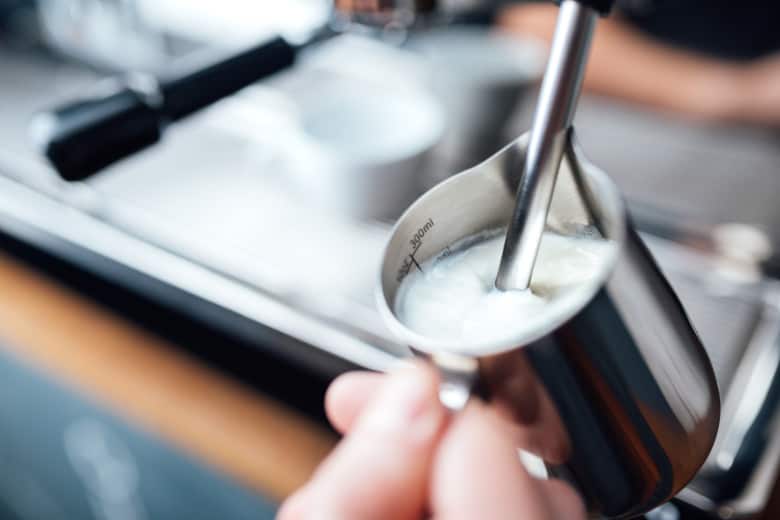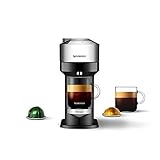For better or for worse, I am an espresso snob. Whether that espresso comes from a machine or a moka pot, it is pretty much a guarantee that I will want to try it.
Over the years I’ve found my absolute favorite machines for brewing the best cup. Unfortunately, those methods can sometimes be very expensive, from a few hundred dollars to a few thousand. Delicious espresso should be something everyone has access to, regardless of budget. Below I’ve reviewed my top picks for the best cheap espresso machine.
I tried 7 inexpensive espresso machines and found that the De’Longhi EC702 15 Bar Pump Espresso Machine was the best overall. The De’Longhi EC702 has everything you could want in affordable espresso machines: great pressure, steamer wand, and beautiful design.
But don’t just take my word for it, read on for more information as well as comparisons to different products on the market.
Let’s Talk Espresso!
Before we dive into the ins and outs of espresso machines, we should first take a moment to run down the basics of making espresso.
What is espresso?
Espresso is a type of coffee. There are many factors at play when a barista makes a cup of espresso: brew time, pressure, and grind size, are all elements that make espresso distinct from a regular cup of joe.
Typically, espresso is brewed for about 30 seconds, at a slightly higher pressure than normal coffee makers. That higher level of pressure allows the most beloved quality of great espresso to develop: the crema. This is the creamy layer of froth that rests just above the surface of espresso.
In general, espresso is known for being a more concentrated version of coffee. Its flavors and mouthfeel are bold and rich and its texture tends to be thicker than normally brewed coffee.

All about frothing milk
Another important topic to cover is frothing or steaming milk. Velvety smooth and subtly sweet, properly frothed milk is an integral part of any true espresso drink. Here are a few quick tips to make sure that no matter which machine you’re using, your milk turns out just right:
- Always clean/purge your steamer wand first
- Only steam cold milk
- Once enough air has been incorporated, dip the steamer wand below the surface of the milk until the air vent has been covered, this allows the milk to continue heating up without incorporating too much air
- Heat milk up to about 160 degrees to maintain good flavor
- Swirl milk in pitcher before pouring into espresso, this allows for a smoother texture
Now that we’ve covered the basics, let’s move on to my favorite products for preparing this delicious beverage.
Best Overall: De’Longhi EC702 15 Bar Pump Espresso Maker
The De’Longhi EC702 is my top choice for an entry-level espresso machine that makes flavorful lattes and cappuccinos. The espresso maker comes with 2 pressurized portafilters, a side-sitting 44 ounce water reservoir, and a Panarello steam wand. All of these features are perfect for beginners.
The pressurized portafilters take out the guesswork that would typically be involved in professional espresso making. With De’Longhi’s portafilters, the user doesn’t need to worry about grind size or even distribution when tamping.
Another great feature of this machine is that it works with both regular espresso grounds as well as E.S.E. pods (not to be confused with Nespresso or Keurig pods).
Pros:
- Beginner-friendly
- Good price point
- Can pull a double shot
- Takes either E.S.E pods or regular coffee grounds
- Pannarello steam wand makes frothing milk easy
Cons:
- Pressurized portafilters make customization difficult
- Precise frothing difficult with wand
- Heat time can take up to 15 minutes
Best Runner Up: Gevi 15 Bar Espresso Machine
The Gevi 15 Bar Espresso Machine is a great choice for more budget-conscious consumers who still want an elevated experience. This little machine boasts an impressive 15 bar pressure system, 2 separate thermostats for heating water and the steam wand, and a warming tray for your cup. While at a lower price point, this machine still offers impressive quality.
The Gevi offers some unique features such as a 42 ounce transparent water tray and a temperature dial so you know just how hot your water or wand will be. These are helpful features for both beginners and slightly more advanced espresso aficionados.
Pros:
- Low price point
- Beginner-friendly features
- Cup warmer
- Water filter
- Great steamer wand capable of making both regular foam and microfoam
Cons:
- Some wait time between heating water and heating steamer wand
Best Pod Espresso Machine: Nespresso Vertuo Next
No espresso machine article would be complete without mentioning Nespresso. The company is famous for its line of pod-based coffee-making products and with good reason.
The espresso these machines produce is rich and utterly delicious. A little different than your classic cup, but satisfying nonetheless. The Vertuo Next offers consumers versatility–it makes both espresso and coffee.
This sleek and slim system is simple to use and looks great in any kitchen. It’s perfect for people on the go, who value a good cup of espresso or coffee without all the frills. Especially nice is that all of this can be done with the touch of a button, no wands, portafilters, or tamping necessary.
Pros:
- Easy to use
- Quick and efficient
- Doesn’t take up counter space
- Can make both coffee and espresso
- Wide range of options from the Nespresso pod collection
- Welcome set of 12 different Nespresso pods included with purchase
Cons:
- No steamer wand/milk frother
- Very little customization possible
- Does not produce a “classic” espresso shot
- Pod collections can be expensive
Best for New Espresso Lovers: Mr. Coffee Espresso and Cappuccino Maker
This semi-automatic espresso and cappuccino maker is perfect for those wanting something simple yet versatile. It doesn’t have all the bells and whistles of typical espresso machines, which is why this is great for someone who wants to enjoy basic espresso drinks like lattes, cappuccinos, and americanos.
This Mr. Coffee maker is yet another 15 bar system, meaning that it is set at the ideal pressure for pouring a satisfying shot of espresso.
An added bonus is the milk frother, which takes the place of a steaming wand. This is a great feature for people who want to elevate their regular cup of coffee but are not ready yet to get into the finer points of espresso drinks.
Pros:
- One-touch system is easy to use and automatic
- Milk frother makes steamed milk easy
- Easy to Clean
- Inexpensive
Cons:
- Does not come with a steamer wand
- Only pours one shot of espresso at a time
- More experienced consumers may find this product limiting
Best Higher End Espresso Machine: Calphalon Temp iQ
For those who want a slightly more luxurious experience without breaking the bank, the Calphalon Temp iQ is a sure fit. This sleek stainless steel machine has a single dial that lets users select between a number of shots, steam, and hot water capabilities.
One of my favorite features of this machine is the steamer wand. This is a classic wand, much more suited to espresso lovers who are more familiar with the ins and outs of how to steam milk. Users can manipulate the milk to produce results for a variety of classic espresso drinks like flat whites, cortados, and more.
It also comes with a 2 liter water reservoir, a greater capacity than most other espresso machines.
All of these excellent features come at a higher price point, however, which is why I recommend this product only for those who are more serious about their daily espresso.
Pros:
- Option for pouring one or two shots
- Timeless aesthetic
- Hot water dispenser
- More flexibility with steamer wand
- Quick heating times
- 2L water reservoir
- Cup warmer
- Simple and consistent quality
Cons:
- Higher price point
- No measuring spoon included
- May take some practice to master
Best Budget Model: DeLonghi EC155
This model is not only a great bang for your buck, it’s the perfect beginner machine. For those who still want the “espresso experience,” but who don’t want to worry about manually tweaking things, the Delonghi EC155 is a great choice.
This beginner-friendly model comes with a steamer wand that makes milk frothing easy. You can pull two shots of espresso at a time.
While this product is on the lower price end, it still uses 15 bar pressure to ensure a nicely brewed cup with good crema and classic espresso flavor.
Pros:
- Lightweight and compact size
- Conveniently designed 34 ounce water reservoir
- Beginner-friendly
- Two in one portafilter holders
Cons:
- Better for coarse grinds and darker roasts
- Not always consistent in quality of shots
Best Design: Gevi 20 Bar Compact Professional Espresso Machine
I love how ergonomic this machine is: it fits perfectly in tight corners of the kitchen, it’s lightweight and incredibly efficient. For anyone who appreciates great design and simplicity, the Gevi 20 Bar machine is a dream.
This espresso maker has all the features any serious espresso lover would want. Its steamer wand is pared down and simple, while still delivering high-quality results.
This is a machine that can, with some practice, produce beautiful microfoam, a must for anyone who enjoys flat whites, cortados, and cappuccinos.
Pros:
- Lightweight and compact design
- Two in one portafilter holders
- Convenient transparent water reservoir
- Very quiet
- Cup warmer
- Automatic shut off after 15 minutes
Cons:
- Sometimes difficult to clean
- Can take a while to heat up
- Prone to dripping
Buyer’s Guide
A good budget espresso machine has to be affordable while having all the features needed for a good quality espresso. Here’s a list of some of the more important things to consider when comparing models.

Size
If kitchen counter space is in short supply, then size becomes a critical factor when evaluating an espresso machine. For instance, a kitchen in a small apartment probably cannot afford the space for a big, hulking espresso machine. If this is your situation, a model with a small footprint is the way to go.
Ease of Use
These days, espresso machines are pretty easy to operate. At this price point, most machines will have a simple control system that allows you to choose between brewing the coffee or frothing the milk.
If a machine is confusing or complicated to use it will probably stay in the box.
Appearance
Most espresso machines tend to look alike. Modern and stylish, in black/silver/stainless steel, like most kitchen appliances. A few brands offer some models in a variety of colors. Of course, beauty is in the eye of the beholder, so only you can decide which model is worthy of being displayed in your kitchen.
Pressure
Most espresso makers produce 15 bars of pressure. This is the optimal amount of pressure for producing a flavorful, rich crema.
Beans or Pods
You will need to choose if you prefer the authenticity of coffee beans (whole or ground) or the convenience of pods. One is not necessarily better than the other. Take into consideration that nowadays, coffee pods like ones from Nespresso or Keurig are available in dozens of different blends. If you’re going with whole espresso beans, you’ll need a separate grinder since none of these models come with their own built-in grinder.

I have a Nespresso that produces a great cup of coffee and couldn’t be simpler to use. This is critical for me since my brain isn’t functioning until after I get my fix of caffeine.
Ease of Maintenance
Modern espresso makers are designed for easy cleaning. Easy disassembly along with dishwasher-safe parts make it relatively painless.
Don’t forget every so often, your unit will need to be descaled to eliminate mineral build-up. Most models will notify you when it’s time.
Water Reservoir
The capacity of the water tank typically goes hand-in-hand with the overall size of the unit. If you are shopping for a smaller espresso machine, then expect the water tank to hold around 40oz or so, larger machines can go up to 1.5-liters. If you only need a cup or two at a time, reservoir size really is unimportant. The only downside is needing to fill it more frequently.
A nice feature to look out for is a removable water tank. Being able to remove the reservoir and fill it in the sink certainly makes things easier.
Milk Steaming/Frothing
More high-end automatic espresso machines can add milk directly into your cup and froth it. However, we’re looking at more bare-boned models, some of which have a steaming wand which you can froth the milk manually. It may be a bit more work but it gets the job done.
Related: Coffee Maker Buying Guide: How To Find Your Perfect Choice.
Conclusion
All the products reviewed here fit a wide range of espresso lovers, from beginners to aficionados. One trait they all share is that they are cheaper models that still provide high-quality results. Hopefully, you’ve found the perfect espresso machine for you.
My personal favorite for everyday use is the De’Longhi EC702, offering a balance of affordability and efficiency. It’s a great product for those just starting out on their espresso making journey, and for those who have been at it for a while.
My other choice would be the Calphalon Temp iQ for those who are willing to invest a little more in their espresso. Still, this product is definitely higher in price, so for anyone who wants to stay on budget, the Gevi 15 Bar Espresso Machine is another solid option.
No matter which product you choose, you are sure to enjoy the simple delights of a perfect, crema topped cup of classic espresso.







